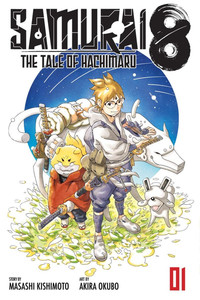Review
by Rebecca Silverman,Samurai 8: The Tale of Hachimaru
GN 1
| Synopsis: |  |
||
Hachimaru was born with a compromised immune system and a weak body – so weak, in fact, that he can't survive without being hooked up to a special machine his father made. Despite that, Hachimaru dreams of becoming a samurai and one day going out into the galaxy to save people. His dream turns out to be closer than he thinks when his slight-defective robot dog brings home what at first looks like a daruma, but turns out to be Daruma, a legendary samurai. With Daruma's help, Hachimaru begins the transformation that will turn him into the true samurai he's always wanted to be. |
|||
| Review: | |||
Cyborg samurai – in space! Talking cats – who are also samurai! A mysterious galaxy-saving artifact named after Greek mythology! Yes, Samurai 8: The Tale of Hachimaru has all of this and more (a tank that looks like a cake!), making it clear that it's been designed with the maximum enjoyment of the eight-to-eleven-year-old set. That's not a bad thing, and the good-hearted nature of the volume makes it enjoyable for older readers as well, but it's definitely a series that is going to appeal on a different level than many of the other shounen books being released. That it hones in on this particular age range while still being entertaining for others is unsurprising given the book's pedigree – it's written by Naruto creator Masashi Kishimoto. Although he doesn't draw it – Akira Ōkubo provides the art – it picks up on appealing kiddy lit trends of the moment without feeling completely derivative. As anyone who's been in a bookstore or library can attest, that's not always easy. Perhaps the most striking way that Kishimoto pulls this off is with his protagonist, Hachimaru. When we first meet him, he's a young teen living trapped in his house hooked up to a life support system. Hachimaru cannot ingest solid food, has a weakened immune system, and is clearly emaciated – and he's resentful about all of it. While intellectually he understands why his father won't let him leave, emotionally he just wants to be what he perceives to be “normal,” and the fact that he can't be is a thorn in his side. He compensates by playing samurai VR games and maintaining that one day he's going to be a samurai, despite understanding on some level that it's not likely. It's not, however, as unlikely as it might at first seem. That's because in the unspecified future, samurai are actually cyborgs – mostly robotic beings with human elements. They're powered by “keys” which transform their frail human bodies and allow them to even breathe in space, rendering them almost invincible. (This definitely feels like a shout-out to classic science fiction series like Tekkaman.) While the world's lore is still largely underdeveloped in this volume – there may be a reason why books one and two were released simultaneously in Japan – for Hachimaru, this system offers a very real glimpse of freedom, because it's his body that's the problem. Does this smack of wish fulfillment of a slightly different nature than we usually see in manga? Yes, to a degree, and for some readers (or parents of readers), the idea that Hachimaru has that his life is worth less before his transformation could be problematic. But it doesn't seem to be intended as anything other than a variation on the theme of “weak guy gets strong and gets the girl” that we see elsewhere, and if at times Kishimoto's version feels a little tone-deaf, it is off-set by the fact that Hachimaru's father clearly loves his son no matter what. That Hachimaru has trouble realizing that feels like more of a product of his age than anything else, and a few times he realizes that he's gone too far in his tantrums, or outbursts, if you prefer, and then struggles with how he can best make things up to his father. While this is nice, it also makes for the transitions in the story to feel a bit disjointed. Whether this is because Kishimoto is used to drawing his own series and thus didn't give Okubo enough direction or for some other reason, there are gaps in the story's continuity that are far too noticeable. A major one is when Hachimaru leaves home with his robo-dog and Daruma, the samurai currently residing in an anthropomorphic cat body; after pages of back-and-forth with his father, he just is off on his journey with nary a reaction or good-bye scene. Likewise his interactions with Nanashi, a nonbinary character he meets hiding away at a training school, feels anti-climactic, just sort of fizzling out when the plot's need for the two to be together ends. There isn't great explanation of the whole princess-and-samurai system either, although that may be resolved in the second volume, since Ann isn't introduced until the very end of this book. Samurai 8: The Tale of Hachimaru is off to an uneven start, but it does have decent potential and is likely to be a hit with younger readers as-is. It's deft use of popular themes in international children's literature is key here, and if the world feels too underdeveloped right now, that does stand to be corrected in the second volume. Okubo's art has a pleasing crowdedness to its panels and just the right amount of weirdness to the cyborg samurai designs, so even if this volume doesn't quite catch you, it may be worth giving it a second to see if things even out. |
| Grade: | |||
|
Overall : B-
Story : B-
Art : B
+ Good use of popular kids' themes, interesting premise. Art works well. |
|||
| discuss this in the forum (14 posts) | | |||
| Production Info: | ||
|
Full encyclopedia details about |
||